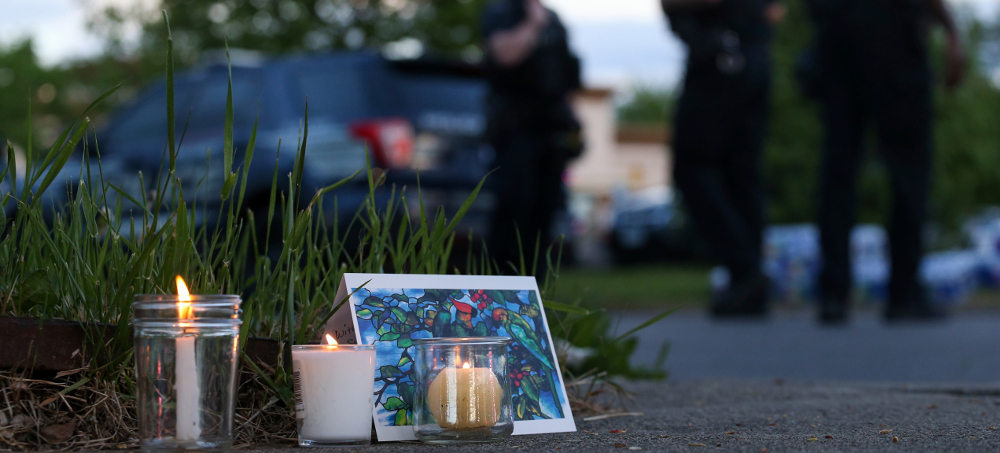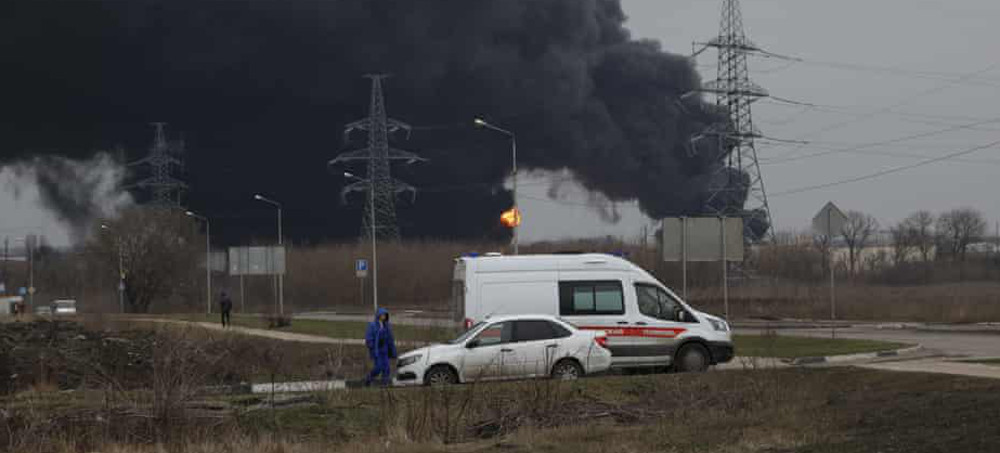Live on the homepage now!
Reader Supported News
Yuliia Paievska (also known as Taira) recorded 256 gigabytes of video on a body cam she wore for over two weeks while she and her colleagues tried to save people from the impact of Russia’s ongoing invasion of Ukraine. She gave the flash drive to reporters from the Associated Press, asking them to take it with them as they fled Mariupol back in March while they were being hunted by the Russians.
From the AP:
On March 15, a police officer handed over the small data card to a team of Associated Press journalists who had been documenting atrocities in Mariupol, including a Russian airstrike on a maternity hospital. The office contacted Taira on a walkie-talkie, and she asked the journalists to take the card safely out of the city. The card was hidden inside a tampon, and the team passed through 15 Russian checkpoints before reaching Ukrainian-controlled territory.
The AP released footage from Taira’s excursions, showing her journeys into war-torn areas as she provided assistance to Ukrainian citizens and wounded Russian soldiers alike. One of the most emotional clips released shows Taira working with her company to treat an injured young child, but she turns away in anguish and says “I hate (this)” as it became apparent the boy would not survive.
The AP reports that on March 16, Taira and her driver were captured by the Russians, who forced her on television and portrayed her team as affiliated with the nationalist Azov Battalion. This plays into Russia’s continuous, false attempts to justify their invasion of Ukraine as a campaign against Neo-Nazism.
A video aired during a March 21 Russian news broadcast announced [Taira’s] capture, accusing her of trying to flee the city in disguise. Taira looks groggy and haggard as she reads a statement positioned below the camera, calling for an end to the fighting. As she talks, a voiceover derides her colleagues as Nazis, using language echoed this week by Russia as it described the fighters from Mariupol.
The broadcast was the last time she was seen.
Watch above, via Associated Press.
 The eighteen-year-old who committed a racist killing spree in Buffalo last weekend spent many months developing his plans on the Internet and live streamed the killing on Twitch. (photo: Joshua Bessex/AP)
The eighteen-year-old who committed a racist killing spree in Buffalo last weekend spent many months developing his plans on the Internet and live streamed the killing on Twitch. (photo: Joshua Bessex/AP)
The eighteen-year-old who committed a racist killing spree in Buffalo last weekend spent many months developing his plans on the Internet.
Gendron, who was indicted by a grand jury on Thursday for first-degree murder, was hardly the first mass shooter to make use of a disturbing kit of Web sites and apps to plan, execute, and document an attack. The Christchurch killer, in 2019, also live-streamed his rampage, on Facebook, for as long as seventeen minutes. A German mass shooter the same year used Twitch to broadcast his attack outside a synagogue; it was seen by more than two thousand people on the platform. Parts of Gendron’s writings were lifted directly from the Christchurch shooter’s own manifesto, which was posted on social media and has become a reference point for racist extremists. In El Paso, Texas, the far-right gunman who killed twenty-three people at a Walmart, in 2019, published a screed on the forum 8chan. Discord has reported that it banned more than two thousand communities that were “organizing around hate, violence, or extremist ideologies” in the second half of last year. Yet Gendron freely discussed the minutiae of his violent plans on the platform. What’s most chilling about his reams of messages is how racist bile and criminal scheming coexist alongside the kinds of mundane updates that can be found everywhere on the Internet. “the White population in the US will be REPLACED by shitskins,” Gendron wrote, using a racist slur. He announced his aim to “take back the cities” from nonwhite people and described his support for eugenics. He posted about assault-rifle magazines, live-stream-technology troubleshooting, and what he ate for lunch. “I had a very bad night of sleep, I would be working on my manifesto but I cant think right now,” he wrote. He recommended weapons stores (“I like the guy at Vintage Firearms”) and noted, of going to a flea market with a friend, “It was a nice break from preparing for the attack.” He researched when his targeted Tops grocery store, which is situated in a majority-Black neighborhood, was most likely to be full of locals: “3-5 PM is where it’s busiest according to google maps.” He tallied out loud how many people he hoped to kill: “I’m expecting 10-20 people dead from area 1, 5-10 people dead from area 2, and another 5-10 people dead from area 3.”
Discord has become a haven for Gen Z-ers, who use it to hang out with their friends online, but older generations who still rely on Twitter and Facebook may be wholly unaware of it. Like Twitch, which is owned by Amazon, Discord emerged from the gaming industry, marketing itself to players who needed to talk with one another in real time. (Video games were once blamed for influencing their players to commit violence; today it seems obvious that the content of games is less pertinent than the demographic that gaming Web sites attract: bored and isolated male adolescents.) Since Discord launched, in 2015, it has grown into an all-purpose tool for hosting various kinds of digital communities. More than a hundred and fifty million monthly users connect on the platform through chat, video streams, and live audio conversations. The Discord app looks a bit like the workplace tool Slack, if Slack allowed you to flip through many different groups at once. When you log in, the left side of your screen shows a vertical bar of avatar thumbnails representing various chat rooms to which you belong, plus direct messages with individual users. Once you’ve clicked into a group, you can select from different topical sub-channels. (Plate Land, for instance, had a #bag-general channel, for discussions of gear, and another called #weapon-talk.) The user experience is chaotic and geared toward obsessive engagement. Unless you’re monitoring your updates and notifications constantly, they’re likely to pile up into an incomprehensible mass. Picture trying to monitor a dozen different Twitter accounts at once in a single interface.
As others have pointed out in recent days, “lone wolf” is something of a misnomer for right-wing terrorists whose ideas and methods are being explicitly nurtured through online communities. Such extremists don’t become radicalized solely by perusing the automated algorithmic feeds that the rest of us see on Facebook or YouTube. They seek out forums for those who have similar views, follow charismatic voices, and egg one another on. A mass shooter who finds inspiration in Christchurch or encouragement in chat rooms isn’t a solo operator or a spontaneous “copycat” so much as a digital comrade-in-arms. Many of Discord’s servers, as they’re called, are open to anyone and thus searchable on a central directory, not unlike Reddit’s browsable channels, or subreddits. But many others are private, which means that they can be accessed only by those with a link from their administrators. Discord told me, through a spokesperson, that Gendron was posting his messages in an “invite-only server” that he used as a “personal diary chat log.” According to the spokesperson, no one else saw the contents of the server until roughly thirty minutes before the shooting, when “a small group of people” were invited to join. Discord wouldn’t comment on whether Gendron was active on the platform beyond Plate Land and his personal server. But even when he was purportedly posting privately, he seemed aware of his own potential to influence others. “Im quite uncomfortable giving out so much of my personal thoughts and feelings, but perhaps it’ll be useful for someone,” he wrote on Discord, on March 4th. In some ways, the forces that encourage mass shooters are bleakly similar to those that fuel the careers of any influencers, drawing passive content consumers into the orbit of particularly vocal posters.
In other ways, though, the digital tools that extremists favor are breaking with the dominant social networks of the past decade. Live-streamed videos are notoriously hard to moderate and censor, because they must be caught and removed in real time. Whereas YouTube requires users to have a fifty-person following before they’re permitted to live-stream, Twitch is designed to let anyone broadcast immediately. (The company said this week that Gendron “has been indefinitely suspended from our service” and that it is “monitoring for any accounts rebroadcasting this content.”) Discord, meanwhile, is part of a movement in social media to create smaller, more private online communities for those eager to flee the Internet’s chaotic “public squares.” But the flight to privacy, as it’s sometimes called, makes identifying problematic user activity more difficult. Watchdog groups and journalists often spot problematic content on digital platforms such as YouTube or Facebook before the platforms themselves act to remove it. That outside observation becomes much more difficult when content is hidden from public view, so platforms must be relied on to track communications internally. Unlike on WhatsApp or other encrypted-messaging services, Discord’s hired moderators can review private content. According to the company spokesperson, Discord has a devoted “Counter-Extremism sub-team” and uses a “mix of proactive and reactive tools,” including machine learning, to root out violent and hateful ideologies “before they are reported to us.” Yet Gendron freely posted about his violent plans up until just days before he carried them out. On May 1st, he wondered, “Maybe I should block the one of the backdoors of tops with my car? Just saw how the binghamton shooter did his attack, I haven’t even thought of blocking the doors.” On May 9th, he wrote, “No matter what do what is right for you people and your race.” Discord said that it only became aware of Gendron’s personal server and shut it down “immediately following the attack.” The question now is why the platform’s detection mechanisms so blatantly failed. (On Wednesday, New York attorney general Letitia James announced an investigation into Twitch, Discord, and other platforms in connection with the shooting.)
Keeping extremist content off of social platforms will always be a necessary game of whack-a-mole. As Kathleen Belew, a scholar of far-right extremism, wrote in a recent Times op-ed, the replacement theory that shooters such as Gendron espouse has moved from the fringes into the mainstream, and the “window for action is closing.” Yet, even if a platform manages to root out a hate group before something terrible happens, it can’t stop the members from regrouping elsewhere online. An instructive example comes from the online activity leading up to the January 6th riot on the Capitol. One long-running subreddit focussed on pro-Trump content, r/donaldtrump, was banned after the invasion, for hosting calls for violence. Users of the subreddit had committed “policy violations,” according to a Reddit statement. But another subreddit that had been previously banned, r/The_Donald, reëmerged before January 6th as a Web site called TheDonald.win, where users were also active in planning the riot. When that site was shut down, too, on January 21, 2021, its users moved to the domain Patriots.win. In the case of the first forum, Reddit’s crackdown was too little, too late; in the case of the second, the platform’s response was more timely but still ineffectual. Gendron’s constant “shitposting” on Discord was evidently central to his planning of mass murder; without that venue, it’s possible that he would not have gone through with his attack. Unfortunately, it’s equally possible that he would have simply brought his compulsive plotting someplace else.
 Smoke rises after an apparent attack by Ukraine on a fuel depot in Belgorod, Russia, on 1 April. (photo: Anadolu Agency)
Smoke rises after an apparent attack by Ukraine on a fuel depot in Belgorod, Russia, on 1 April. (photo: Anadolu Agency)
Locals speak of a tense atmosphere after a number of attacks – and reports of Ukrainian saboteurs
“On Sunday, we were woken up again by explosions. You never know if it’s them or us firing,” said Vladimir, a shopkeeper in the city.
Locals such as Vladimir first witnessed Russia’s military buildup at the start of the year, when thousands of troops amassed near Belgorod before Moscow’s attack in late February.
“When the conflict started, we would hear rockets being launched into Ukraine. But now we get hit too. It is a different sound.”
As the war has dragged on and Russia failed in its objective to quickly seize Kyiv, officials in Belgorod and other border cities have in recent weeks reported a series of attacks by Ukrainian forces.
Ukraine has not directly accepted responsibility but has described the incidents as payback and “karma” for Russia, almost three months after it invaded its neighbour.
The apparent Ukrainian attacks, which started when two helicopters struck an oil depot in Belgorod on 1 April, have brought a new element into the war, raising the previously unthinkable possibility that some of the devastating damage that Moscow has inflicted on Ukraine will come to Russia’s own territory.
“We talk a lot about what is happening, of course. The atmosphere in the city is sort of tense,” said Anna, a local teacher.
“Life goes on, but sometimes it is impossible to ignore it, like the time the city was in thick smoke,” she said, referring to the fuel depot attack.
In this week alone, officials in Belgorod reported at least three attacks. Last week, Vyacheslav Gladkov, the governor of the Belgorod region, claimed a strike on a small town in the area had killed one Russian civilian.
During the last week, Ukrainian forces have recaptured villages from Russian troops north and north-east of Kharkiv, pushing them back towards the border near Belgorod. This has given some relief to Kharkiv, Ukraine’s second-largest city, which is only an hour’s drive from Belgorod and has been under enemy bombardment since the war began in February.
And while the consensus among military experts remains that Ukraine will not aim for a push into Russian territory, its advances have been met with unease in Belgorod and across Russia.
In a recent live Q and A with locals, Gladkov was forced to answer questions from worried voters about what the recent Ukrainian advances would mean for Belgorod. The governor tried to offer reassurance but admitted that certain parts of the region were under “constant shelling”.
He has also raised the city threat levels to “yellow”, the second-highest in a three-tier system, and a heavier police presence is now being felt across the city, according to Anna.
There have also been reports of two fires at defence ministry facilities in the Belgorod region as well as damage inflicted to a key Russian railway bridge, leading to speculation that Ukrainian saboteurs have been active on Russian territory. Russian officials have not commented on the incidents, and it remains unclear what caused the fires.
Nikita Parmenov, a journalist at the independent Fonar outlet, said the lack of information regarding some of the recent fires has led to “fears and gossip that Ukrainians have infiltrated the towns and villages in the region”.
Still, despite the direct threat posed by Ukraine, Parmenov said there were no visible signs of an upsurge in patriotism in Belgorod.
“Many here have direct links with Ukraine, they talk to relatives across the border. It feels like we have a better understanding of what is going on than most regions in Russia,” said the journalist, who has himself been in contact with his aunt from Odesa.
“Enthusiasm for the special military operation feels muted. It has torn some families apart, while others prefer not to speak about the conflict with their friends and siblings in Ukraine.”
But it is not just Ukrainian attacks that have disrupted life on Russia’s borderlands – the war has had broader effects, too. Since the start of the invasion, Moscow has suspended the work of 11 airports in parts of central and southern Russia that are close to Ukraine, citing the “difficult situation surrounding Ukraine”, and hindering travel for millions of Russians.
Among the airports shut are those serving popular holiday destinations, including some in the annexed Crimean peninsula and the Black Sea resort towns of Gelendzhik and Krasnodar.
“I am expecting a disastrous summer holiday season,” said one hotel owner in Sevastopol.
During the first weekend of May, when Russians usually travel to the country’s south, the hotel occupancy rate in Crimea was 10–15%, according to a study by the Russian business outlet Kommersant.
The Crimean tourism industry expects that up to 70% of hotel rooms will remain empty over the summer holidays because of difficulties travelling to Crimea and worries that the peninsula is too close to the war.
“It is going to be a tough summer,” said the owner of the mid-sized Crimean hotel. “But in war, you have to make sacrifices.”
 An unarmed 13-year-old was shot by Chicago police officers on Wednesday. (photo: John J. Kim/Chicago Tribune)
An unarmed 13-year-old was shot by Chicago police officers on Wednesday. (photo: John J. Kim/Chicago Tribune)
The child was said to be in stable condition, but the incident came little more than a year after the fatal shooting of 13-year-old Adam Toledo in the same city.
According to police, they stopped the car that night shortly after 10 p.m., believing it to have been tied to a “vehicular hijacking” in a suburb a day earlier. Officials said someone described as an “offender”—and later as a 13-year-old—fled the car and was shot by at least one officer before being brought to a hospital in serious but stable condition.
Cops indicated the driver of the car fled the scene and avoided arrest, abandoning the vehicle shortly thereafter. At least one officer was put on administrative leave while the shooting is investigated by the Civilian Office of Police Accountability.
The incident comes in the wake of numerous high-profile police shootings of teenage Chicagoans. Perhaps the most immediate and relevant precedent: the case of Adam Toledo, another 13-year-old who was killed by police, in his case while holding his hands up in apparent surrender.
While police originally leaned on the fact that Toledo appeared to have been in possession of a gun that night, video later showed he had his hands in the air when he died. No officers were charged in the fatal episode.
In 2014, Chicago police officer Jason Van Dyke killed 17-year-old Laquan McDonald. Video released showed McDonald had been walking away from police when he was shot 16 times. Multiple officers were subsequently implicated in a cover-up, and Van Dyke was convicted on murder charges and sentenced to prison before being released earlier this year.
 A follow up survey by the Census Bureau found significant undercounts in six states. (photo: AP)
A follow up survey by the Census Bureau found significant undercounts in six states. (photo: AP)
Which states had significant miscounts in the 2020 census?
A follow-up survey the bureau conducted to measure the national tally's accuracy found significant net undercount rates in six states: Arkansas (5.04%), Florida (3.48%), Illinois (1.97%), Mississippi (4.11%), Tennessee (4.78%) and Texas (1.92%).
It also uncovered significant net overcount rates in eight states — Delaware (5.45%), Hawaii (6.79%), Massachusetts (2.24%), Minnesota (3.84%), New York (3.44%), Ohio (1.49%), Rhode Island (5.05%) and Utah (2.59%).
For the other 36 states, as well as Washington, D.C., the bureau did not find statistically significant net over- or undercount rates.
These revelations come after the population totals from a census beset by the coronavirus pandemic and years of interference from former President Donald Trump's administration have already been used to divvy up seats in the House of Representatives, as well as votes in the Electoral College, for the next decade.
"No census is perfect," Census Bureau Director Robert Santos warned during a public webinar about the latest results from Post-Enumeration Survey. "And the PES allows us to become more informed about the 2020 census by estimating what portion of the population was correctly counted, where we missed people and where some people were counted that shouldn't have been."
During a press briefing on Wednesday, bureau officials emphasized the follow-up survey's estimates, which were delayed largely because of the pandemic, will not change each state's share of representation in the House or the Electoral College.
The Supreme Court ruled in 1999 that statistical sampling, which would be needed to factor in the states' over- and undercount rates, cannot be used to produce the census data for reapportioning Congress.
Last year, the House clerk certified each state's new share of House seats based on the 2020 population tallies.
The bureau, however, does plan to use these estimates from its Post-Enumeration Survey in planning for the 2030 census that is already underway.
"It's a monumental task to count everybody. And this helps us inform how well we do," said Timothy Kennel, assistant division chief for statistical methods, during the briefing.
It's hard to say exactly why certain states were miscounted, but there may be some clues
Census Bureau officials are quick to point out that their report does not get into what caused these net over- and undercounts by state.
However, Allison Plyer, a former chair of the bureau's scientific advisory committee, says that Alabama and Georgia not appearing on the list of significantly miscounted southern states could be seen as a telling sign of the effectiveness of census promotion efforts in those states.
"A lot of the southern states were hit with disasters, hurricanes while door-to-door work was going on," says Plyer, who is the chief demographer at the nonprofit The Data Center in New Orleans. "But the one thing that states have control over is their own get-out-the-count efforts."
In particular, Texas, one of the states with a significant net undercount, stands out to Plyer. "We know that Texas invested very little in get-out-the-count, and when they did so, it was very late in the process," she says.
The bureau has been under pressure to release more quality metrics
Kennel, the Census Bureau official who led the follow-up survey's design, said that the new results were "in line with past censuses" that had over- and undercounts among various states.
Still, the 2020 results stand in stark contrast to the findings from the bureau's follow-up survey for the 2010 census, which had no statistically significant over- or undercounts for any state.
Concerned about the impact of COVID-19 and interference by Trump administration officials, many state and local officials, civil rights groups and other census stakeholders have been pressing for more quality metrics from the bureau.
"More data and demographic detail are needed for a full understanding of our communities and who does — or does not — have access to critical resources," said Meeta Anand, senior director of census and data equity at The Leadership Conference on Civil and Human Rights, in a statement. "The Census Bureau also needs to be adequately funded to ensure that inequities from inaccurate counts do not persist into 2030 and beyond."
Past counts have shown that census participation and the quality of the final numbers can vary greatly between neighborhoods and demographic groups.
In March, the bureau released follow-up survey findings that showed significant national net undercount rates for Black people and Latinos, as well as Native Americans living on reservations. The bureau also found significant national net overcount rates for white people who do not identify as Hispanic and Asian Americans.
The statistical agency, however, is not expected to release state-level over- or undercount rates by race and ethnicity or any rates for counties, cities or towns.
"We are interested in producing the highest quality estimates that people can rely on and trust. And we have to meet our standards, and we can't really say anything below the state level," Kennel said during Wednesday's press briefing, noting that the bureau's plans for the 2020 count did not include producing more detailed metrics as it had in the past.
On Thursday, Kennel added that the bureau is exploring the possibility of releasing additional national-level metrics about more specific demographic groups, such as racial groups by age or sex.
"I'm not going to commit to anything at this point, but we're definitely looking into that," Kennel said.
To try to ameliorate the effects of the over- and undercounts, the bureau has set up an internal team that plans to research how to factor the follow-up survey's results into the bureau's population estimates, which, along with census data, help guide the distribution of an estimated $1.5 trillion a year in federal money to local communities.
 President Joe Biden and Saudi Crown Prince Mohammed bin Salman. (photo: AP)
President Joe Biden and Saudi Crown Prince Mohammed bin Salman. (photo: AP)
Biden administration officials are in talks with the Saudis about arranging a potential in-person meeting while the President is overseas next month, current and former US officials said. Saudi Arabia currently holds the presidency of the Gulf Cooperation Council, so any engagement between Biden and bin Salman, known as MBS, would likely coincide with a meeting of the GCC in Riyadh, the sources noted.
"You should count on something like this happening, it just comes down to when, not if," a former US official familiar with the discussions said. Saudi officials did not respond to a request for comment.
A meeting between American and Saudi leaders would have once been considered routine, but now marks a significant shift due to the recent strain in the relationship. It would also likely spark some controversy at home for Biden, who has been highly critical of the Saudis' record on human rights, its war in Yemen, and the role its government played in the murder of the journalist Jamal Khashoggi.
For Biden, a return to better relations with Saudi Arabia reflects the sometimes uncomfortable choices a leader must make when navigating the complex politics of oil, human rights and the web of Middle Eastern relations.
Talk of a rapprochement with the Saudis, the world's largest exporter of crude oil, comes as gasoline prices continue creeping higher in the US.
The balance is particularly difficult because Biden repeatedly criticized his predecessor, Donald Trump, for his cozy relationships with the world's strongmen and dictators -- including MBS of Saudi. Biden entered office vowing to restore democratic values to US foreign policy and had sought to recalibrate relations with Riyadh.
Biden has not engaged directly with MBS, considered the day-to-day ruler of Saudi Arabia, since taking office, opting instead to speak directly with MBS's father, King Salman, the ailing 86-year old monarch.
The President was opposed to engaging with Prince Mohammed as a matter of principle because of his role in the murder of Khashoggi, US officials said. Just three months into Biden's presidency, his chief of intelligence released a declassified report stating that MBS was ultimately responsible for Khashoggi's grisly murder.
The Biden administration sanctioned Saudi officials who were part of the hit team but stopped short of penalizing MBS himself. Officials said Biden believed taking action against the prince directly could cause irreparable damage to a relationship that is critical for counterterrorism and confronting Iran.
Biden did, however, announce in February 2021 that he was ending US support for the Saudi-led war in Yemen and also reversed the Trump-era decision to designate the Iran-backed Houthi rebels as terrorists.
Post-Ukraine reset
Biden himself has remained cautious in how to approach Saudi Arabia, officials said, hoping to both avoid a full breakdown in relations while still maintaining his commitment to promoting democracy abroad.
With that dynamic as a backdrop, the National Security Council's Middle East Coordinator Brett McGurk and the State Department's Senior Adviser for Global Energy Security Amos Hochstein have been working behind the scenes to repair the relationship. The pair have traveled to Saudi Arabia four times since December, one senior official told CNN, most recently to Riyadh in February where they met with MBS directly to try to build diplomatic goodwill and lay the groundwork for a potential meeting between Biden and the crown prince.
Discussions have become more urgent over the last two months, as the US has tried to isolate Russia globally over its attack on Ukraine -- only to see MBS refuse to condemn the Russians and repeatedly decline, on behalf of OPEC, to increase oil output.
On Tuesday, MBS' younger brother Khalid bin Salman traveled to Washington, DC and met with US National Security Adviser Jake Sullivan, Hochstein and other officials. KBS, as he is known, is also co-chairing a meeting of the US-Saudi Arabia Strategic Joint Planning Committee this week at the Pentagon.
As Russia's invasion of Ukraine continues to roil global energy markets and the West is forced to rely on other sources of oil -- from allies and foes alike -- there have been increased debates within the administration about the importance of maintaining a positive relationship with Saudi Arabia, despite its egregious human rights record.
Some in the White House, including Chief of Staff Ron Klain, have repeatedly emphasized how high gasoline prices are hurting the President politically.
Russia, meanwhile, has sought to undercut US attempts to build back its relationships with Saudi Arabia and the Gulf countries. The Kremlin has in recent weeks proposed hosting a meeting of its own of the Gulf Cooperation Council, which would cut out the United States, two sources familiar the deliberations told CNN.
Balancing act
At the same time, some officials have voiced a desire to avoid the appearance that Biden is backing away from his pledge to keep democratic values at the forefront of his foreign agenda. The White House is highly attuned to what would likely be bipartisan opposition on Capitol Hill to a full rapprochement with Saudi Arabia.
On top of the high-profile killing of Khashoggi, who was a US resident, the Biden administration has repeatedly expressed alarm over Saudi Arabia's human rights abuses of its own citizens. The administration is also tracking at least three Americans who are unable to leave the Kingdom because they are under a Saudi travel ban. US lawmakers from both parties have reached out to Biden to ask him to work to release Sarah and Omar Aljabri, the children of former senior Saudi counterterrorism official Saad Aljabri, who have been imprisoned.
Aljabri, who worked for years with US national security officials and maintains close relations with them, has accused MBS of sending assassins to Canada to kill him. The head of US intelligence, Avril Haines, intervened last year in a case brought against Aljabri by MBS-backed companies that accused him of embezzlement because she said it threatened to reveal US national security secrets.
In a recent plea to the White House, Aljabri offered to settle all financial and legal disputes with Saudi Arabia if his children are returned.
The Iran question
Discussions over a Saudi meeting come at the same time the Biden administration is trying to wrap up negotiations with Saudi Arabia's regional archrival, Iran, on a new nuclear deal.
Saudi Araba has been waging war in Yemen against Iran-backed rebels, the Houthis, in a devastating conflict that the US has supported militarily. In January, the Houthis claimed an attack on Abu Dhabi, in the United Arab Emirates, which UAE leaders felt the US did not respond to aggressively enough.
This week, the US sent a high-level delegation led by Vice President Kamala Harris to the UAE for the funeral of its president, Sheikh Khalifa bin Zayed Al Nahyan, a deliberate attempt to smooth things over, observers said.
For those who have worried that the Biden administration has weakened security partnerships with two key Arab allies, a potential meeting between Biden and GCC leaders this summer would be a welcome change.
"Because of our multiple shared national security interests, [a meeting] is a good thing," said the former US official familiar with the meeting discussions.
READ MORE A California condor flies along the Big Sur coast. (photo: Mark Miller/Getty)
A California condor flies along the Big Sur coast. (photo: Mark Miller/Getty)
Scientists at San Diego State University (SDSU) and San Diego Zoo Wildlife Alliance (SDZWA), in collaboration with Centro de Investigación Científica y de Educación Superior de Ensenada and the National Oceanographic and Atmospheric Administration (NOAA), conducted research and found that dead marine life along California’s coast had about seven times more DDT and 3.5 times as much PCBs compared to dead marine life near Baja California, Mexico.
The findings, published in Environmental Science … Technology, showed that California condors living in coastal areas of the state had higher levels of contaminants in their blood compared to inland condors, which do not feed on marine life. DDT levels in coastal condors were about seven times higher than inland condors, and PCBs were about 40 times higher.
The researchers further found over 400 contaminants in total in the marine life samples, which are a common food source for the condors.
“This kind of broad survey of contaminants shows us that the condors and the marine mammals have a multitude of contaminants that have never really been examined before, especially in detail,” explained study co-author Nathan Dodder, an analytical chemist and research scientist in the School of Public Health at SDSU and the SDSU Research Foundation. “The non-targeted contaminant analysis we used not only identifies known legacy contaminants, but has the added advantage of identifying novel contaminants, in addition to known but less-examined contaminants that are not routinely screened.”
DDT (dichloro-diphenyl-trichloroethane) was banned in 1972, and PCBs (polychlorinated biphenyls) were banned in 1979. But since these endocrine-disrupting chemicals do not easily or quickly break down, they still persist in the environment. For condors, these contaminants have been linked to the thinning of egg shells, causing reproductive disruption in the critically endangered species.
In 2021, scientists found at least 27,000 barrels laced with DDT off the coast of California, as DDT waste was formerly dumped into the oceans. This chemical, formerly a widely used pesticide, was banned due to its negative environmental impacts and threats to public health.
In the 1980s, the California condor was nearly extinct, with just 22 individuals remaining. A captive breeding program has helped the species recover and return to the wild, but these birds are still vulnerable to several threats, including lead poisoning and electrocution from power lines. The high levels of contaminants in condors around the California coastline raises further concern, and more research is needed for some of the other contaminants, aside from DDT and PCBs, that were found in the study.
“These findings can help inform management of the Baja flock as it continues to grow,” noted co-author Christopher Tubbs, associate director of reproductive sciences at SDZWA. “Some of the contaminants present in marine mammal samples that we collected are ‘unknown’ in terms of their structure and potential to disrupt hormone function. This study exclusively looked at one hormone pathway, estrogen, but many of the contaminants identified are well known to interfere with multiple hormone pathways. These warrant further study.”
Special Coverage: Ukraine, A Historic Resistance
READ MORE
Follow us on facebook and twitter!
PO Box 2043 / Citrus Heights, CA 95611



No comments:
Post a Comment
Note: Only a member of this blog may post a comment.